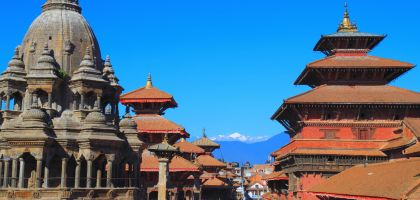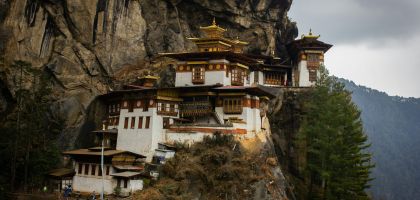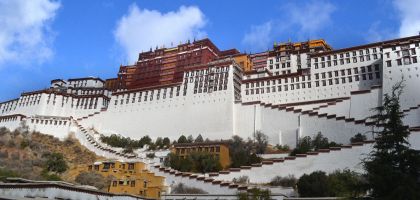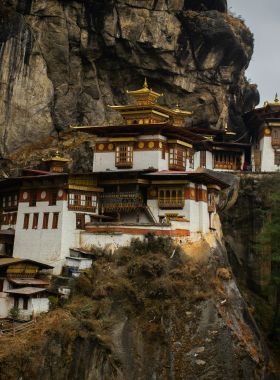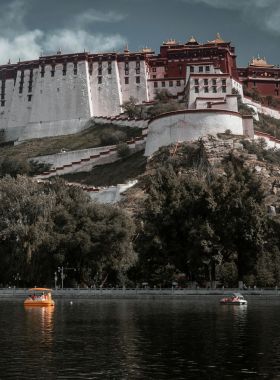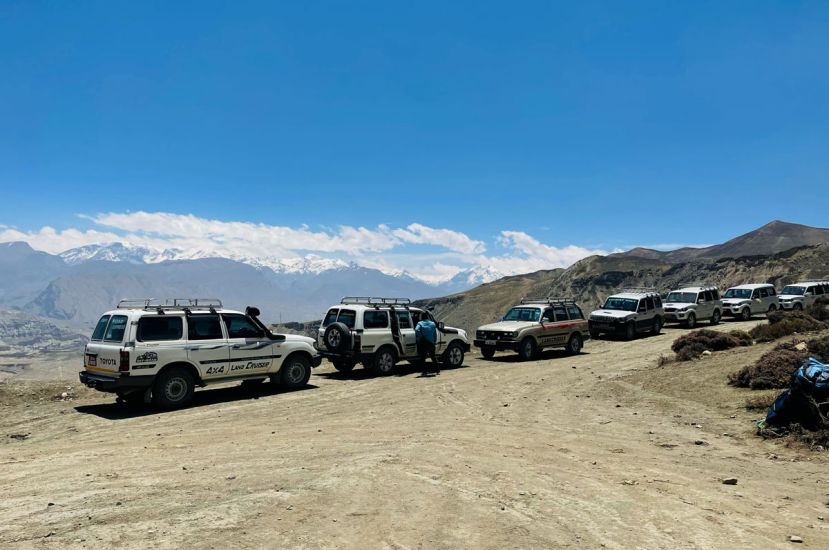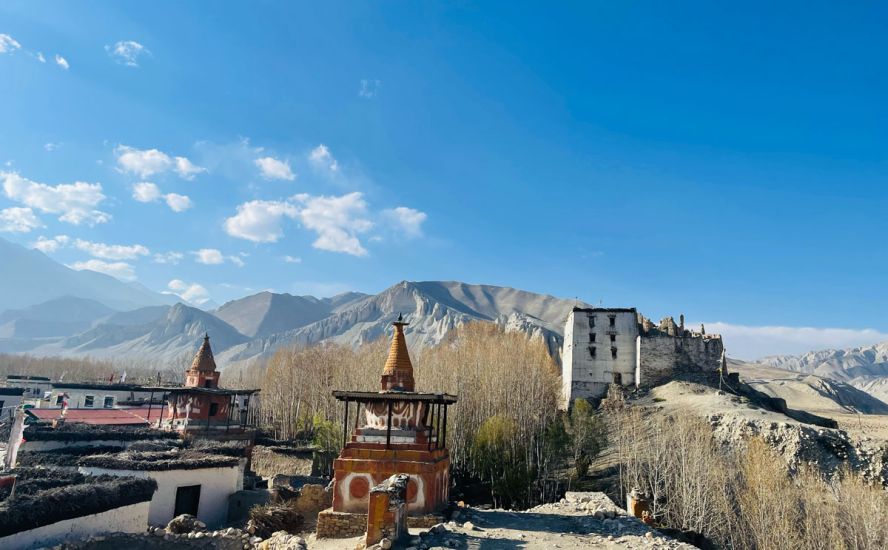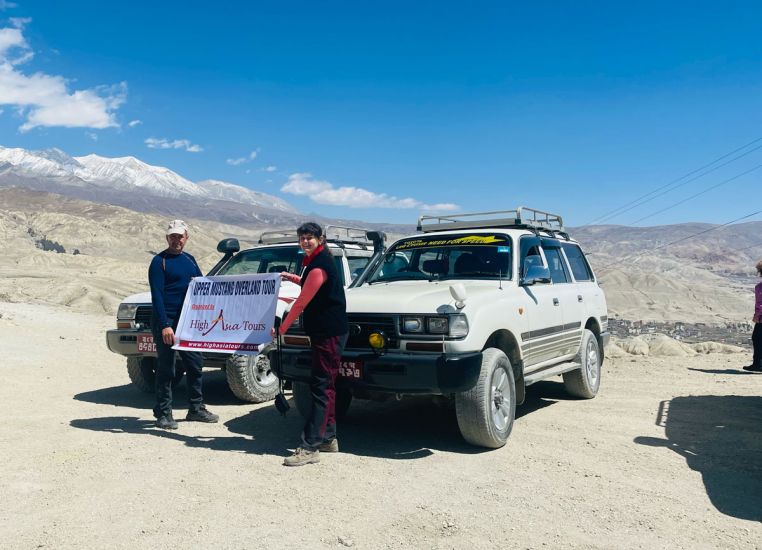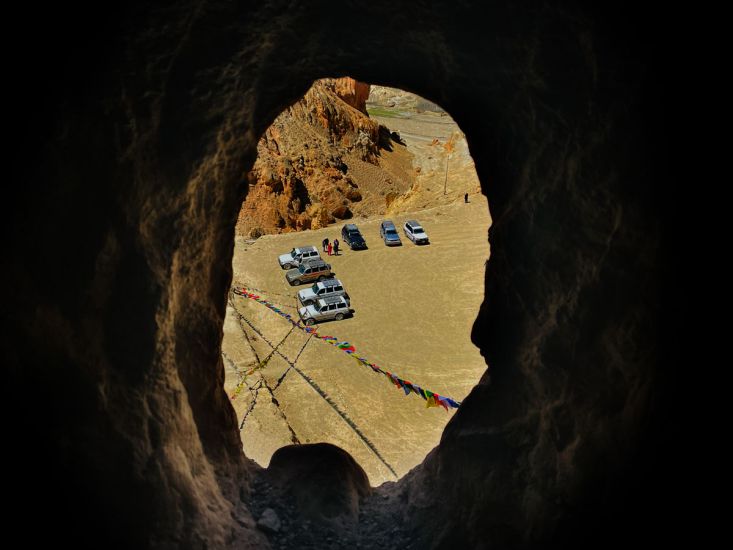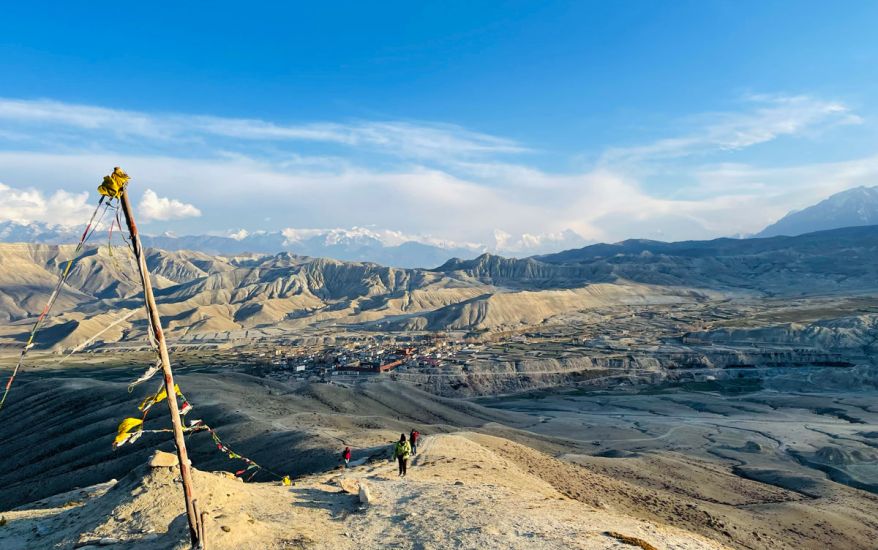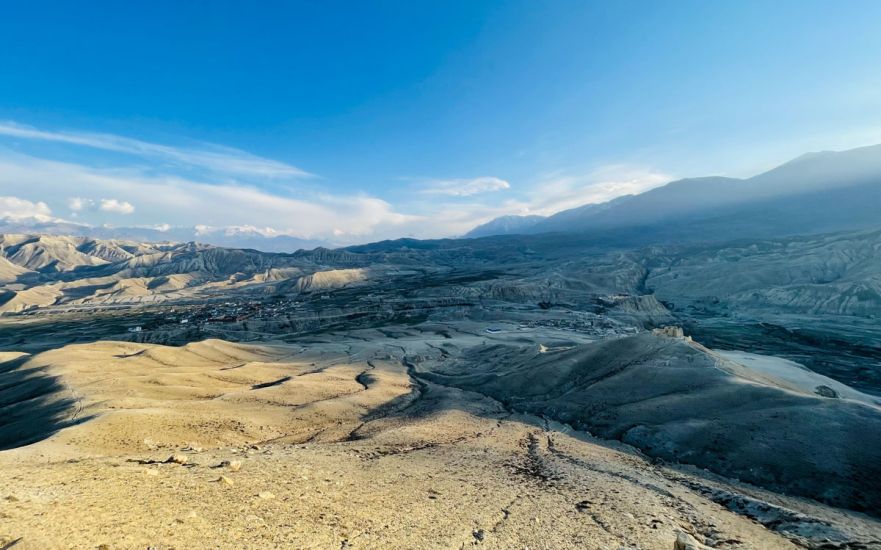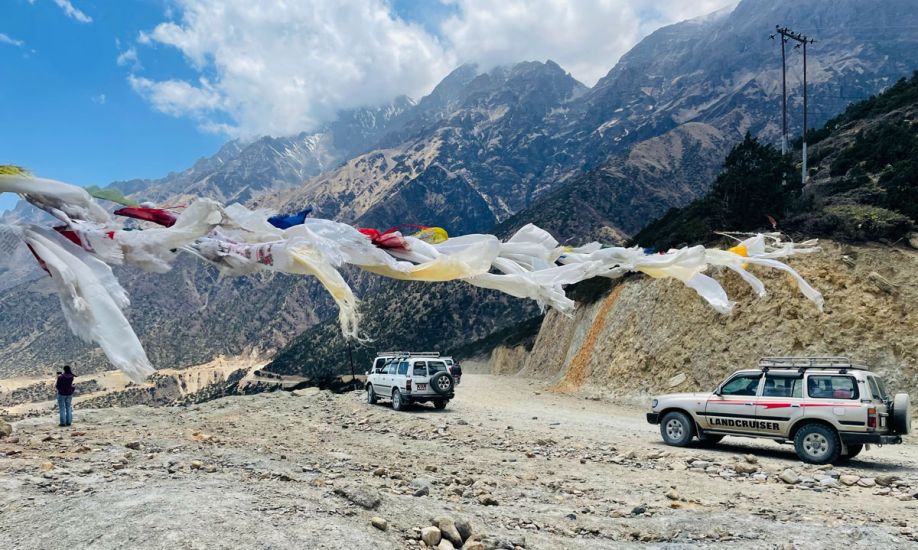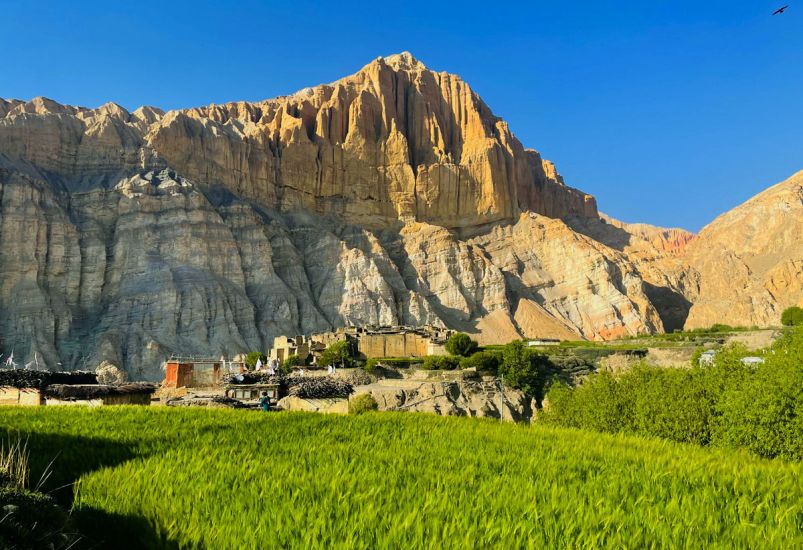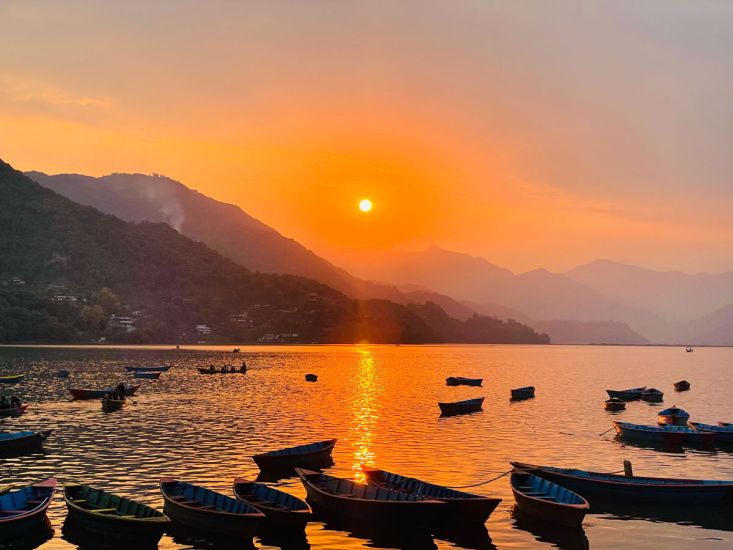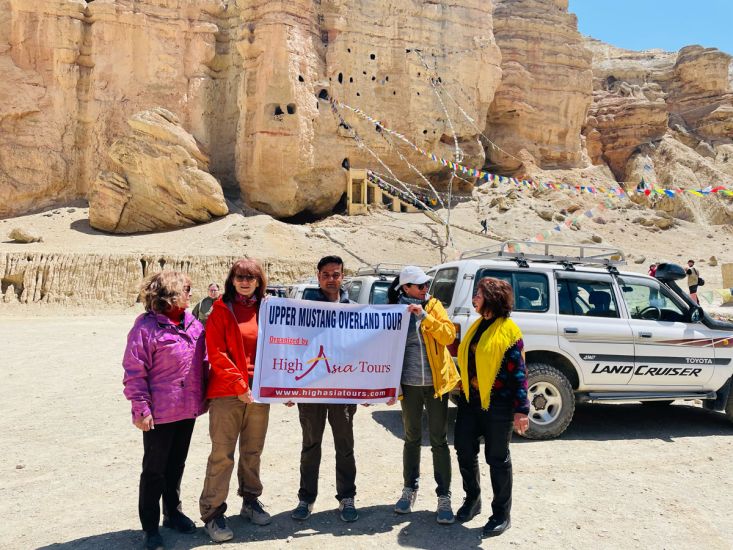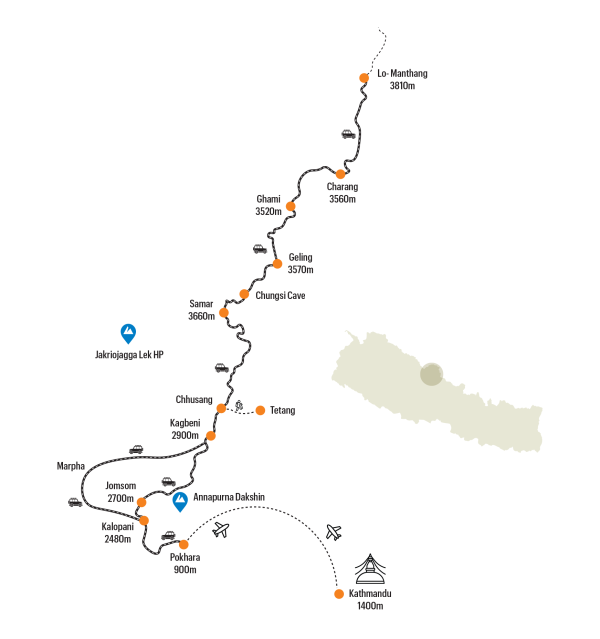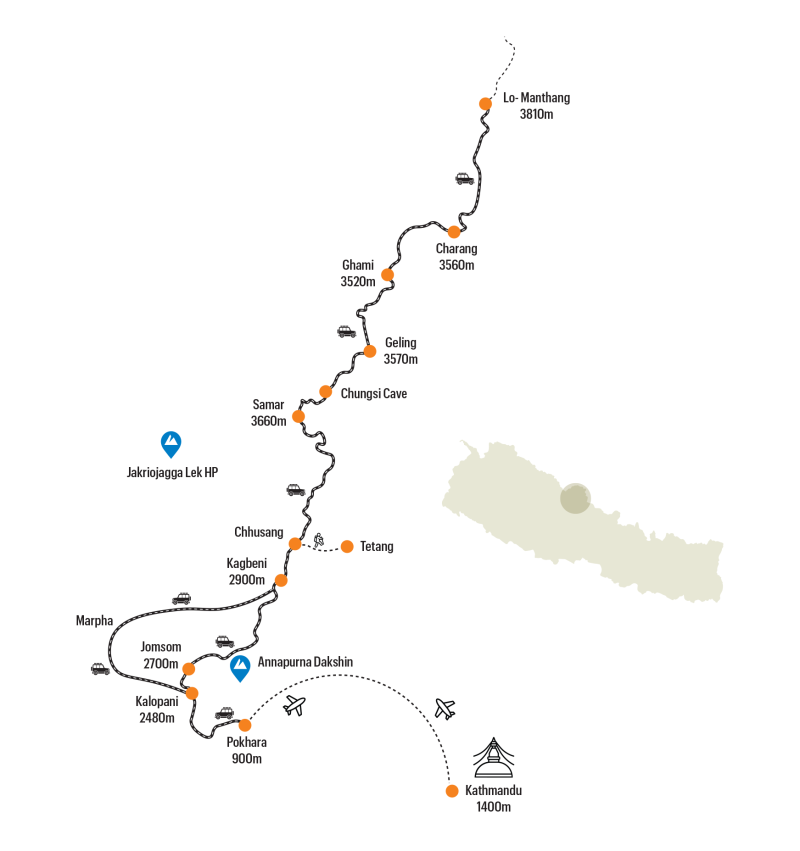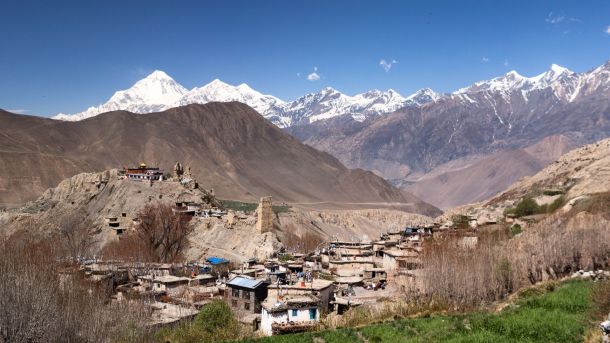Mustang Overland Tour
12 Days / Nepal
Activity
Difficulty Level
Destinations
Trip Start / End
Max Altitude
Accommodation
Travel Style
Best time to travel
Personalized Travel Advice

Dev Raj Nepal
+977 9851096523
Personalized Travel Advice

Dev Raj Nepal
+977 9851096523
Detailed Itinerary
01
DAY
01
Welcome to Nepal! Upon arrival at Tribhuvan International Airport, you will be warmly greeted and escorted to your hotel in the heart of Kathmandu. Please ensure you have your passport and a legible copy of your travel insurance policy ready for verification.
In the evening, enjoy a warm introduction to Nepali culture with a traditional welcome dinner featuring local cuisine and folk performances. Settle in at a hotel in Kathmandu.
Arrive in Kathmandu
Welcome to Nepal! Upon arrival at Tribhuvan International Airport, you will be warmly greeted and escorted to your hotel in the heart of Kathmandu. Please ensure you have your passport and a legible copy of your travel insurance policy ready for verification.
In the evening, enjoy a warm introduction to Nepali culture with a traditional welcome dinner featuring local cuisine and folk performances. Settle in at a hotel in Kathmandu.
02
DAY
02
This morning we arrange for the necessary permits for our upcoming journey. Later, we take a short 25-minute flight west to Pokhara, a serene lakeside city often described as ‘the jewel of the Himalaya’. With its crisp mountain air, sweeping views of the Annapurna range, and a landscape adorned with lush hills and shimmering lakes, Pokhara has long inspired travelers and writers alike.
The valley is home to a cluster of nine lakes, the most prominent being Phewa, Begnas, and Rupa, each offering moments of stillness and natural beauty. With the snowcapped Himalayas reflected in calm waters and adventure awaiting in every direction, Pokhara serves both as a tranquil retreat and as the gateway to the legendary Annapurna region, where many a traveler begins their search for Shangri-La. In the evening, you can take a walk along the lake side which is lined with numerous cafes and restaurants. Spend the night at a hotel in Pokhara.
Fly to Pokhara
This morning we arrange for the necessary permits for our upcoming journey. Later, we take a short 25-minute flight west to Pokhara, a serene lakeside city often described as ‘the jewel of the Himalaya’. With its crisp mountain air, sweeping views of the Annapurna range, and a landscape adorned with lush hills and shimmering lakes, Pokhara has long inspired travelers and writers alike.
The valley is home to a cluster of nine lakes, the most prominent being Phewa, Begnas, and Rupa, each offering moments of stillness and natural beauty. With the snowcapped Himalayas reflected in calm waters and adventure awaiting in every direction, Pokhara serves both as a tranquil retreat and as the gateway to the legendary Annapurna region, where many a traveler begins their search for Shangri-La. In the evening, you can take a walk along the lake side which is lined with numerous cafes and restaurants. Spend the night at a hotel in Pokhara.
03
DAY
03
Our Mustang overland tour begins today. This morning marks the start of our overland journey as we board our Jeep and head north, tracing the course of the Kali Gandaki River. The drive begins gently, passing through lush lowland villages and terraced fields, before reaching the bustling town of Beni, where the landscape starts to change dramatically.
Beyond Beni, the road narrows and begins its steep, winding ascent. The air becomes clearer, and the surroundings more rugged, as the dust-laden path gives way to stone-paved stretches. As we climb higher, the snowy silhouette of Nilgiri gradually reveals itself, followed by breathtaking views of Dhaulagiri’s massive south face and the towering Annapurna range.
With every turn, the landscape grows more majestic. The river gorge, one of the deepest in the world, slowly widens, and the Kali Gandaki Valley begins to open into a sweeping expanse of alpine terrain. Along the way, you’ll see cascading waterfalls, isolated mountain hamlets, and prayer flags fluttering from hillside chortens.
By late afternoon, we arrive in Kalopani, a peaceful village ringed by forests and surrounded by snow-draped peaks. Here, we rest and take in the beauty of the mountains in the quietude of the high Himalayas.
Overnight at a tea house in Kalopani.
Drive to Kalopani
Our Mustang overland tour begins today. This morning marks the start of our overland journey as we board our Jeep and head north, tracing the course of the Kali Gandaki River. The drive begins gently, passing through lush lowland villages and terraced fields, before reaching the bustling town of Beni, where the landscape starts to change dramatically.
Beyond Beni, the road narrows and begins its steep, winding ascent. The air becomes clearer, and the surroundings more rugged, as the dust-laden path gives way to stone-paved stretches. As we climb higher, the snowy silhouette of Nilgiri gradually reveals itself, followed by breathtaking views of Dhaulagiri’s massive south face and the towering Annapurna range.
With every turn, the landscape grows more majestic. The river gorge, one of the deepest in the world, slowly widens, and the Kali Gandaki Valley begins to open into a sweeping expanse of alpine terrain. Along the way, you’ll see cascading waterfalls, isolated mountain hamlets, and prayer flags fluttering from hillside chortens.
By late afternoon, we arrive in Kalopani, a peaceful village ringed by forests and surrounded by snow-draped peaks. Here, we rest and take in the beauty of the mountains in the quietude of the high Himalayas.
Overnight at a tea house in Kalopani.
04
DAY
04
Kagbeni sits at the edge of the Upper Mustang, where the Kali Gandaki winds through a barren, windswept valley framed by ochre cliffs and distant snow peaks. Its cluster of flat-roofed houses, narrow alleys, and ancient monastery reflect a strong Tibetan influence, both culturally and architecturally. Just getting here feels like a passage into a different world.
As you make your way north from Jomsom, the change in landscape is immediate. Vegetation thins out dramatically, giving way to the stark beauty of the Himalayan rain shadow. To your right, the sharp summit of Nilgiri South dominates the skyline, more imposing than ever. You’ve now crossed the main Himalayan divide, entering the arid Mustang region. The transformation isn’t only visual; the cultural shift is equally striking, with each village echoing Tibetan heritage more deeply than the last. Kagbeni, an hour beyond Jomsom, marks the threshold of this unique high-altitude world. Lodging at a tea house in Kagbeni.
Drive to Kagbeni
Kagbeni sits at the edge of the Upper Mustang, where the Kali Gandaki winds through a barren, windswept valley framed by ochre cliffs and distant snow peaks. Its cluster of flat-roofed houses, narrow alleys, and ancient monastery reflect a strong Tibetan influence, both culturally and architecturally. Just getting here feels like a passage into a different world.
As you make your way north from Jomsom, the change in landscape is immediate. Vegetation thins out dramatically, giving way to the stark beauty of the Himalayan rain shadow. To your right, the sharp summit of Nilgiri South dominates the skyline, more imposing than ever. You’ve now crossed the main Himalayan divide, entering the arid Mustang region. The transformation isn’t only visual; the cultural shift is equally striking, with each village echoing Tibetan heritage more deeply than the last. Kagbeni, an hour beyond Jomsom, marks the threshold of this unique high-altitude world. Lodging at a tea house in Kagbeni.
05
DAY
05
After breakfast, our journey starts to Upper Mustang. After the permits are checked at the police post in Kagbeni, the jeep track today pretty much skirts the side of the Kali Gandaki River Valley. Whether there is any water in the river depends on what time of year you’re undertaking the journey. Usually, from October to mid-May, the broad river floor looks more like a level boulder field. Take a walk onto the riverbed, and you may just hear water flowing underneath. Along the way, you can take a halt and explore the small villages and see how their carefully tended terraced fields are irrigated in a landscape that is otherwise dry and barren wilderness. At Chusang, there is a river tributary to cross, and shortly thereafter the Kali Gandaki Riverbed itself. After crossing the Kali Gandaki, the jeep track now climbs away from the valley, and there are a couple of high passes (approx. 4000m) to cross before dropping down into Charang. Overnight stay at Kagbeni.
Drive to Charang
After breakfast, our journey starts to Upper Mustang. After the permits are checked at the police post in Kagbeni, the jeep track today pretty much skirts the side of the Kali Gandaki River Valley. Whether there is any water in the river depends on what time of year you’re undertaking the journey. Usually, from October to mid-May, the broad river floor looks more like a level boulder field. Take a walk onto the riverbed, and you may just hear water flowing underneath. Along the way, you can take a halt and explore the small villages and see how their carefully tended terraced fields are irrigated in a landscape that is otherwise dry and barren wilderness. At Chusang, there is a river tributary to cross, and shortly thereafter the Kali Gandaki Riverbed itself. After crossing the Kali Gandaki, the jeep track now climbs away from the valley, and there are a couple of high passes (approx. 4000m) to cross before dropping down into Charang. Overnight stay at Kagbeni.
06
DAY
06
We set this day aside for acclimatization, allowing the body to adjust to the altitude as we prepare for the days ahead. Charang, the second-largest settlement in Upper Mustang after Lo Manthang, is a quiet village immersed in history and rich in cultural charm. Its maze of whitewashed houses, ancient chortens, and expansive barley fields offer plenty to explore on foot.
For those eager to stretch their legs and enjoy the crisp mountain air, a rewarding hike leads up to Ghar Gompa. This ancient monastery, said to have been founded by the revered Padmasambhava, is perched high on a windswept ridge. As you ascend, prayer flags flutter in the wind and wide views unfold across the arid, ochre-colored landscapes of Mustang. The gompa itself is modest yet spiritually significant, often visited by pilgrims who believe that wishes made here are fulfilled.
You can either prefer to wander along the alleys of Charang or take the hike to Ghar Gompa today. Both these options offer a perfect balance of rest, exploration, and immersion in the mystical highland atmosphere of Upper Mustang. Night stay in Charang.
Acclimatization Day
We set this day aside for acclimatization, allowing the body to adjust to the altitude as we prepare for the days ahead. Charang, the second-largest settlement in Upper Mustang after Lo Manthang, is a quiet village immersed in history and rich in cultural charm. Its maze of whitewashed houses, ancient chortens, and expansive barley fields offer plenty to explore on foot.
For those eager to stretch their legs and enjoy the crisp mountain air, a rewarding hike leads up to Ghar Gompa. This ancient monastery, said to have been founded by the revered Padmasambhava, is perched high on a windswept ridge. As you ascend, prayer flags flutter in the wind and wide views unfold across the arid, ochre-colored landscapes of Mustang. The gompa itself is modest yet spiritually significant, often visited by pilgrims who believe that wishes made here are fulfilled.
You can either prefer to wander along the alleys of Charang or take the hike to Ghar Gompa today. Both these options offer a perfect balance of rest, exploration, and immersion in the mystical highland atmosphere of Upper Mustang. Night stay in Charang.
07
DAY
07
The tour continues as we set off on the final stretch of our journey toward Lo Manthang. The road takes us over a high mountain pass, rising to nearly 4,000 meters, offering sweeping views of Mustang’s wind-sculpted terrain. From the pass, we descend gently along a rugged track, and within two hours, the walled city of Lo Manthang reveals itself on the horizon, an oasis of ochre and white tucked into the stark Tibetan plateau.
Though often referred to as a city, Lo Manthang is more accurately a fortified village of fewer than 200 traditional homes, each bearing the imprint of centuries-old architecture and customs. If travel conditions have been favorable, the afternoon will be free to begin exploring its narrow alleys, ancient monasteries, and royal courtyard. The atmosphere here is timeless, and just walking its streets feels like stepping into a bygone era.
Overnight lodging in Lo Manthang.
Drive to Lo Manthang
The tour continues as we set off on the final stretch of our journey toward Lo Manthang. The road takes us over a high mountain pass, rising to nearly 4,000 meters, offering sweeping views of Mustang’s wind-sculpted terrain. From the pass, we descend gently along a rugged track, and within two hours, the walled city of Lo Manthang reveals itself on the horizon, an oasis of ochre and white tucked into the stark Tibetan plateau.
Though often referred to as a city, Lo Manthang is more accurately a fortified village of fewer than 200 traditional homes, each bearing the imprint of centuries-old architecture and customs. If travel conditions have been favorable, the afternoon will be free to begin exploring its narrow alleys, ancient monasteries, and royal courtyard. The atmosphere here is timeless, and just walking its streets feels like stepping into a bygone era.
Overnight lodging in Lo Manthang.
08
DAY
08
This day is devoted to uncovering some of Upper Mustang’s hidden wonders. After breakfast, we set out on a short trek to Chhoser, a land of dramatic cliffs, silent canyons, and ancient secrets. This area is famous for its remarkable cave complexes carved high into the rock face. Some of these caves date back over a thousand years and were once used as dwellings, meditation chambers, and monasteries.
With a packed lunch, we pause amidst this surreal landscape where the sculpted ridges and eroded formations evoke comparisons to the moon. It is a place of deep silence, broken only by the whisper of wind or the distant sound of passing horses.
After time to explore and absorb the stillness, we return to Lo Manthang. The journey back offers more sweeping views and space to reflect on the depth and mystery of this high Himalayan realm. Overnight in Lo Manthang.
Lo Manthang Exploration
This day is devoted to uncovering some of Upper Mustang’s hidden wonders. After breakfast, we set out on a short trek to Chhoser, a land of dramatic cliffs, silent canyons, and ancient secrets. This area is famous for its remarkable cave complexes carved high into the rock face. Some of these caves date back over a thousand years and were once used as dwellings, meditation chambers, and monasteries.
With a packed lunch, we pause amidst this surreal landscape where the sculpted ridges and eroded formations evoke comparisons to the moon. It is a place of deep silence, broken only by the whisper of wind or the distant sound of passing horses.
After time to explore and absorb the stillness, we return to Lo Manthang. The journey back offers more sweeping views and space to reflect on the depth and mystery of this high Himalayan realm. Overnight in Lo Manthang.
09
DAY
09
Drive to Marpha along the side of the Kali Gandaki Valley; the Himalayan peaks get closer and closer. Marpha is a village perfect for quiet wanderings. As you meander through its narrow, cobbled streets, lined with whitewashed stone houses, you’ll be drawn to the beauty of carved wooden windows, spinning prayer wheels, and the gentle flutter of prayer flags—a serene backdrop that displays the heritage of the Thakali people.
Drive to Marpha
Drive to Marpha along the side of the Kali Gandaki Valley; the Himalayan peaks get closer and closer. Marpha is a village perfect for quiet wanderings. As you meander through its narrow, cobbled streets, lined with whitewashed stone houses, you’ll be drawn to the beauty of carved wooden windows, spinning prayer wheels, and the gentle flutter of prayer flags—a serene backdrop that displays the heritage of the Thakali people.
10
DAY
10
This morning we travel back to Pokhara, which is either a 5hr 45min drive to and overnight there. Stay overnight in Pokhara.
Drive to Pokhara
This morning we travel back to Pokhara, which is either a 5hr 45min drive to and overnight there. Stay overnight in Pokhara.
11
DAY
11
After breakfast, today, we will take a flight to Kathmandu. The flight duration is of 30 minutes. Overnight in Kathmandu.
Fly to Kathmandu
After breakfast, today, we will take a flight to Kathmandu. The flight duration is of 30 minutes. Overnight in Kathmandu.
12
DAY
12
Transfer to airport for flight to Kathmandu or home
Departure
Transfer to airport for flight to Kathmandu or home
Tour Cost
At High Asia Tours, we know that understanding tour costs is essential for planning your trip. Due to variables such as accommodation choices, meal plans, transportation options, group size, and seasonal demand, providing an exact price upfront is challenging.
To assist you, we offer a starting price to give a general idea of the cost:
The starting cost for this tour is
Includes / Excludes
Inclusions
-
Local 3-star hotel in Kathmandu and Pokhara
-
Guesthouse accommodation in Mustang.
-
Breakfast only in Kathmandu and full board in the Mustang region.
-
Arrival and departure transfers in Kathmandu by a Sedan car or van or minibus
-
All transportation in Mustang by Indian made Mahindra Scorpio Jeep. Max 3 Person in one Jeep.
-
Mustang Area Special Permit ($500 per person)
-
Annapurna Area Conservation fee.
-
An English-speaking certified guide, including his accident insurance.
-
Kathmandu to Pokhara, Jomsom to Pokhara to Kathmandu flight fares, If the flight (Jomsom-Pokhara) gets cancelled, the cost of the flight will be used to rent the jeep for the road trip.
-
Sleeping bag and a duffel bag for use during the trip.
Exclusions
-
International flight airfare
-
Nepal Entry Visa Fees for multiple Entries on arrival at Tribhuwan International Airport
-
Meals in Kathmandu, Pokhara.
-
Drinks, tipping, laundry, phone, and other personal expenses.
-
Excess baggage charges (Limit is 9kg per Person)
-
Personal expense (shopping, snacks, boil bottle water, hot and cold drinks, hot shower, Alcohol, telephone call, battery re-charge fee), extra porters etc
-
Personal clothing and gear
-
Travel insurance which has to cover emergency high-altitude rescue and evacuation – compulsory
-
Tips for guide and porters (Recommended by the Culture)
-
Additional costs or delays caused by out of management control, for example, landslide, weather condition, itinerary modification due to safety concerns, illness, change of government policies, strikes etc.
Trip Info
The Mustang Overland Tour follows an ancient route once used by traders and pilgrims, winding through high Himalayan plateaus and timeless stone villages. Traveling by private 4WD vehicle, you move steadily through the Kali Gandaki Valley and into the former Kingdom of Lo. Along the way are deeply rooted cultural sites, dramatic canyons, ochre cliffs, and towns that still echo with Tibetan influence. The journey leads you to Lo Manthang, a remote walled city with royal heritage, sacred monasteries, and windswept alleyways rich with stories. Many travelers used to do the Mustang Trek before (they still do), and it’s equally thrilling. However, due to the availability of roads, and for those who do not prefer long hours of walking everyday, this tour provides a good alternative.
This Mustang overland tour moves through a landscape shaped by wind, time, and devotion. Roads climb past ancient chortens, eroded sky caves, and wide valleys framed by the snow-capped Nilgiri and Dhaulagiri ranges. Each day offers something distinct—whether it’s the quiet presence of a monastery, the dry beauty of Mustang’s high desert, or the simple rhythm of daily life in Upper Mustang. The Mustang Overland Tour brings you into a region where heritage remains intact and the terrain feels endlessly vast.
There are several ways to explore the Mustang region, each offering a different experience depending on time, fitness level, and travel style. Here’s how the Mustang Overland Tour stands apart from the more traditional approaches:
Mustang Overland Tour (Jeep Tour)
- Comfort-focused travel by private 4WD vehicle
- Ideal for travelers short on time or who prefer to avoid multi-day trekking
- Access to all major cultural and natural sites, including Lo Manthang
- Scenic drives through mountain passes, deep gorges, and Tibetan-style villages
- Accommodations in local lodges and guesthouses with basic comforts
- Great for families, senior travelers, and photography enthusiasts
Upper Mustang Trek
- Multi-day trek (usually 10–14 days) through remote trails
- Requires good fitness and stamina; some high-altitude walking involved
- Closer connection with the land and slower cultural immersion
- Fewer road encounters but more physical effort
- Nights spent in teahouses or simple lodges along the trail
- Suitable for avid trekkers seeking a wilderness adventure
The best time to do the Mustang Overland Tour is from April to October. This period offers the most favorable weather conditions and allows travelers to fully experience the region’s unique landscapes and culture.
March to June (Spring/Early Summer)
During spring, the weather is pleasant, with clear skies and moderate temperatures ranging from 16°C to 22°C (61°F to 72°F). The valleys come to life with blooming wildflowers, making it a visually stunning time to explore. This is one of the best seasons for visiting the cultural and religious sites of Upper Mustang. The Mustang region, with its dramatic desert-like landscapes and Tibetan-influenced culture, is at its most picturesque during this time.
Mid-September to November (Autumn)
Clear Views and Comfortable Temperatures: Post-monsoon, the weather is stable with clear skies and stunning views of the surrounding mountains. Temperatures are comfortable ranging from from 14°C to 21°C (61°F to 72°F), making it perfect for an overland tour. This is also a great time to witness local festivals like Tiji, celebrated in Lo Manthang (Upper Mustang), offering an authentic insight into Mustang’s rich Tibetan Buddhist culture.
In Kathmandu and Pokhara, you will stay in a carefully selected 3-star level hotel offering a comfortable and restful environment before and after your journey to Mustang. These hotels feature clean and spacious rooms, en suite bathrooms, reliable Wi-Fi, and attentive service. Located in convenient and safe areas, they provide a peaceful base with modern amenities to help you settle in or unwind after your adventure.
In the Mustang region, accommodation is arranged in locally-run tea houses, which are simple yet welcoming lodges operated by families along the route. These tea houses offer basic rooms, usually with twin beds and shared bathroom facilities, along with hearty home-cooked meals. While the amenities are modest, the experience is rich in warmth and authenticity. Staying in tea houses allows you to engage directly with local life, share stories with fellow travelers, and enjoy traditional Nepali hospitality in the heart of the high Himalayas.
During this Mustang overland tour, you’ll be on a full board meal plan, meaning breakfast, lunch, and dinner are all included throughout the tour. Meals are served in local lodges and guesthouses along the route, with menus that reflect the region’s high-altitude lifestyle, simple, warm, and nourishing. Typical dishes include dal bhat (rice with lentil soup and seasonal vegetables), vegetable soups, fried rice or noodles, chapatis, and sometimes local specialties like buckwheat pancakes or tsampa porridge. While the offerings are basic, they’re freshly prepared and comforting after a day of travel.
In Kathmandu and Pokhara, where more variety is available, your stay includes daily breakfast, served buffet-style in your hotel. Expect a selection of both local and international options like eggs, toast, fresh fruit, yogurt, cereals, tea, coffee, and traditional Nepali items. These urban meals offer a pleasant contrast to the simpler fare in the mountains, giving you a balanced experience throughout the trip.
We can accommodate most dietary preferences, including vegetarian and vegan meals. Please inform us of any allergies or specific food requirements at the time of booking so we can ensure your needs are met during the tour.
The type of vehicle used for this overland tour in the Upper Mustang region depends on the terrain, comfort preferences, and group size. The entire region has rugged terrain with off-road conditions, so robust vehicles are essential. Commonly used vehicles include:
4×4 SUVs (Sports Utility Vehicles)
Here are some of the options:
- Toyota Land Cruiser: Known for its durability, especially for rough and mountainous terrains.
- Mitsubishi Pajero: Another reliable 4×4 SUV for off-road conditions.
- Mahindra Scorpio: Popular in Nepal for both on-road and off-road travel.
- Ford Ranger: Suitable for overland tours due to its strength and off-road capabilities
Since the opening of motorable routes beyond Jomsom, much of the Upper Mustang region has become accessible by 4WD vehicle, but the terrain remains wild, raw, and constantly shaped by wind, rivers, and seasonal weather. This has made the Mustang overland tour accessible to everyone.
From Pokhara to Kagbeni, the roads gradually shift from paved to gravel, with sections that wind along the Kali Gandaki River. Beyond Kagbeni, the journey enters the restricted region of Upper Mustang, where roads become narrower, dustier, and more rugged. Expect unpaved surfaces, occasional landslide-prone areas, and dry riverbed crossings, especially between places like Ghami, Charang, and Lo Manthang. However, most of the roads are not-pitched but generally smooth.
While the ride can be bumpy at times, we use well-maintained 4WD vehicles and experienced drivers who are familiar with the landscape. The slower pace through these sections gives you time to take in the vast desert cliffs, ancient chortens, and panoramic views that unfold with every turn.
The road conditions in Mustang are unpredictable but manageable, and they are a key part of what makes this Mustang overland tour such a memorable experience.
A few essential travel documents are essential for the Mustang overland tour due to the cultural and geographical significance of the area. These permits are required to ensure responsible tourism in this restricted Himalayan region.
1. Nepal Visa on Arrival
All international travelers (except nationals of a few countries) can obtain a tourist visa on arrival at Tribhuvan International Airport in Kathmandu or at designated land border entry points. The process is generally quick and requires a valid passport, and payment in cash (USD is widely accepted). Visas are issued for various durations depending on your travel plans.
2. Restricted Area Permit (RAP) – Upper Mustang
Upper Mustang lies in a specially protected zone of Nepal, close to the Tibetan border. It is considered a Restricted Area, and access is tightly regulated to preserve the region’s unique Tibetan-influenced culture, ancient cave systems, and fragile landscapes.
Travelers are required to obtain a Restricted Area Permit (RAP) before entering Upper Mustang. This permit is only issued through licensed Nepali trekking or tour agencies, and independent travel is not allowed in this region. The permit is valid for a fixed number of days, and extensions beyond that period are subject to strict conditions.
3. Annapurna Conservation Area Permit (ACAP)
In addition to the RAP, travelers must also hold an Annapurna Conservation Area Permit (ACAP). This is required because Upper Mustang falls within the Annapurna Conservation Area, a protected zone known for its biodiversity, high mountain deserts, and dramatic scenery.
The ACAP supports conservation and sustainable tourism in the region. It’s valid for an extended period, making it ideal even for those combining Mustang with other areas in the Annapurna region.
We Handle All Permits for You
Once your booking is confirmed, we take care of all necessary paperwork on your behalf. All we require is a scanned copy of your passport and a passport-sized photo. You won’t need to stand in queues or visit government offices, we’ll ensure your permits are ready before your journey begins.
For more information, Check Nepal Immigration Information
Clothing
- Warm down jacket (preferably packable)
- Fleece or thermal mid-layer
- Lightweight waterproof/windproof shell jacket
- Comfortable trekking pants/travel trousers
- Long-sleeved shirts (for sun protection)
- Breathable base layers (thermal tops and bottoms)
- Warm hat/beanie & sun hat
- Neck gaiter or scarf (also useful against dust)
- Light gloves (fleece or wool)
- Comfortable shoes (for walking around towns and short hikes)
- Thick socks and a few lightweight pairs
Toiletries & Health
- Sunscreen (SPF 30 or higher)
- Lip balm with UV protection
- Hand sanitizer
- Wet wipes / face wipes
- Basic personal medications
- Motion sickness tablets (for bumpy roads)
Gear & Accessories
- Daypack (for water, camera, and daily essentials)
- Reusable water bottle (with purification tablets or filter if desired)
- Sunglasses with UV protection
- Power bank (charging options may be limited in remote areas)
- Headlamp or flashlight (with extra batteries)
- Travel towel (quick-dry)
- Earplugs (for light sleepers)
Optional but Useful
- Camera or smartphone with enough storage
- Travel journal or notebook
- Extra snacks or energy bars
- Dust mask (the roads can get dusty in the Kali Gandaki Valley)
- Small gifts for local children (pens, not candy, if you wish to share)
The Mustang Overland Tour gradually ascends from the lush valleys of Pokhara into the windswept highlands of Upper Mustang. Though you travel by 4WD vehicle, the elevation increases day by day, reaching its highest point in Lo Manthang (3,840 m). Our carefully designed itinerary includes an acclimatization day and overnight stays at intermediate altitudes to help your body adjust comfortably to the thinner air.
Approximate Altitudes by Overnight Stop
Kathmandu – 1,400 m
Pokhara – 820 m
Kalopani – 2,530 m
Kagbeni – 2,840 m
Charang – 3,570 m
Lo Manthang – 3,840 m
Chhusang – 2,980 m
Marpha – 2,670 m
Our Mustang Overland Tour is paced to ascend gradually, and we include a dedicated acclimatization day in Charang (Day 06) before heading to the highest point of the tour. This allows time for your body to adapt naturally and reduces the chance of altitude-related discomfort.
Tips for Staying Well at Altitude
- Hydrate often – Aim for 3–4 liters of water a day.
- Eat regular meals – Carbohydrates are helpful at altitude.
- Limit alcohol and caffeine, especially during the ascent.
- Move gently – Light walks help circulation and adjustment.
- Rest well – Prioritize sleep, especially above 3,000 m.
- Inform your guide – If you feel headaches, nausea, or fatigue.
Our experienced guides monitor your condition throughout the journey and are trained to respond quickly if altitude issues arise. Should any symptoms occur, adjustments to the pace or route can be made for your comfort and safety. The Mustang Overland Tour is designed to be both immersive and manageable, even in one of Nepal’s highest inhabited regions.
Upper Mustang is a culturally rich and spiritually significant region with deep ties to Tibetan Buddhism. As a traveler, showing sensitivity to local customs will enrich your journey and leave a positive impression on the communities you encounter.
Monasteries, mani walls, chortens, and prayer wheels are an integral part of daily life in Mustang. When passing prayer walls or chortens, always walk to the left side (clockwise) as a sign of respect. You’ll often see locals spinning prayer wheels or offering butter lamps. Feel free to observe quietly or participate if invited, but do so mindfully and without interrupting rituals.
When entering monasteries or traditional homes:
- Remove your shoes before stepping inside.
- Avoid pointing your feet toward altars, statues, or people.
- Dress modestly—long sleeves and covered legs are recommended, especially in sacred spaces.
- Photography inside monasteries or of local people should always be done with permission.
- Public displays of affection are best avoided, especially in villages.
In Lo Manthang, respect for the royal family and monastic institutions is deeply rooted. Even casual conversations often reflect traditional values. A small gesture like a respectful nod or a quiet “Tashi Delek” (a Tibetan greeting) can go a long way.
Visitors are welcome, but the region still feels traditional and conservative. Traveling with cultural awareness allows you to experience Mustang in a more meaningful way, and supports the dignity of this remarkable Himalayan society.
Mustang Overland Tour is a journey through one of Nepal’s most unique and culturally rich regions. This remote area, often called the “Last Forbidden Kingdom,” offers a fascinating blend of arid landscapes, Tibetan Buddhist culture, and ancient architecture. This is one of the most scenic regions in the world. Here’s what you can expect during the tour:
Spectacular Scenic Drive
The overland journey takes you through rugged terrain, dramatic cliffs, and winding mountain roads. As you travel by 4×4 jeep, expect to see stunning panoramas of high desert landscapes, deep valleys, and the majestic backdrop of the Annapurna and Dhaulagiri mountain ranges. Along the way, you’ll pass traditional villages, terraced farmlands, and monasteries.
Rich Tibetan Buddhist Culture
Upper Mustang is steeped in Tibetan Buddhist traditions. You will visit Lo Manthang, the walled capital of the ancient kingdom of Mustang, where centuries-old monasteries, chortens, and mani walls are an integral part of the landscape. Expect to encounter the Loba people, who still follow ancient customs and rituals.
Untouched locations
Unlike the more popular trekking routes in Nepal, Mustang remains a relatively untouched region. Expect barren, wind-sculpted cliffs, colorful rock formations, and a semi-arid desert-like environment that contrasts sharply with the lush green landscapes found elsewhere in Nepal.
Basic but Comfortable Accommodations
You’ll stay in local guesthouses or teahouses along the route. These accommodations are simple but cozy, providing a glimpse into traditional Mustang life. Rooms typically offer basic amenities like a bed, shared bathrooms, and simple meals. Some guesthouses may have limited electricity and internet access, so be prepared for a more rustic experience.
Unique Cultural Highlights
Mustang is home to several significant religious and cultural sites. You will visit the monasteries of Lo Gekar, Choser Cave Monasteries, and Tibetan-style palaces. You might also have the opportunity to witness local festivals, such as the Tiji Festival, a three-day event celebrated in Lo Manthang with traditional masked dances.
Jeep Safaris and Off-Road Adventure
The overland tour offers a sense of adventure as you travel through the remote, off-the-beaten-path areas of Upper Mustang. The roads can be bumpy and rugged, adding to the thrill of exploring a region where few tourists venture. Expect to travel along off-road tracks, riverbeds, and passes.
Minimal Crowds
Unlike other popular destinations in Nepal, such as the Everest or Annapurna regions, Mustang sees fewer visitors. This gives you a more authentic and intimate experience of the region, where the culture and landscapes remain relatively undisturbed by mass tourism.
Local Cuisine and Hospitality
During your tour, you’ll have the chance to enjoy local Mustang and Tibetan cuisine, such as dal bhat (lentil soup and rice), momos (dumplings), Tibetan bread, and yak cheese. Meals are hearty and simple, providing energy for the journey ahead. You can also expect warm hospitality from the locals, who take pride in welcoming visitors to their homes and guesthouses.
A Blend of History and Spirituality
Mustang is more than just a scenic destination; it’s a place where history, spirituality, and adventure converge. As you travel through ancient villages, past medieval monasteries, and along trade routes used for centuries, you’ll feel a deep connection to the land and its people.
Upper Mustang is a deeply spiritual landscape shaped by centuries of tradition, devotion and resilience. As visitors, we have the opportunity and responsibility to travel in ways that respect the culture, protect the environment and support the communities we pass through.
The region is arid and fragile. Please help preserve it by minimizing waste, avoiding single-use plastics and using a refillable water bottle whenever possible. Waste disposal services are limited, especially in remote villages, so packing out what you bring in helps keep the landscape clean for future travelers.
Cultural respect is just as important. Always ask before taking photos of people, especially elders and monks. Dress modestly, speak respectfully and observe local customs, especially around monasteries, shrines and religious gatherings. Small gestures like walking clockwise around chortens or offering a quiet greeting show appreciation for the local way of life.
We encourage travelers to support local businesses, eat at village lodges and purchase crafts directly from artisans. Every interaction can help sustain Mustang’s living heritage.
By traveling mindfully, you help protect this remarkable highland for the people who call it home and for those still to come.
Local Tour Operator Based in Nepal
Choosing a Mustang Overland Tour with a local tour operator like us means that it simply isn’t about booking a trip. This is about traveling with people who know the land, live the culture, and care deeply about your journey. We work directly with local guides, drivers, and communities across the Mustang region, ensuring your experience is both genuine and grounded in local knowledge. From navigating remote mountain roads to sharing stories around a hearth in a highland village, we bring you closer to the real Mustang.
As a Nepal-based team, we handle every detail personally, permits, logistics, accommodation, and cultural engagement, while making sure your travel choices benefit the local economy. Our long-standing connections in the region allow for smooth coordination, flexibility, and special moments you won’t find in generic packages. When you travel with a local operator like us, your journey becomes a collaboration between traveler and host, respectful, immersive, and unforgettable.
Safe and Trustworthy
Traveling through remote Himalayan terrain surely requires a good vehicle, but it also demands experienced hands, sound planning, and local foresight. With a local tour operator based in Nepal, your safety is our constant priority. Our guides and drivers are trained, licensed, and familiar with every curve of the Mustang roads. We monitor weather and road conditions, carry backup plans, and remain connected with networks throughout the region to respond to any situation promptly.
Equally important is trust. As a local team with years of experience, we value clear communication, ethical operations, and honest pricing. From airport pick-up to your final day in the Himalayas, we’re there with you as operators, and also as hosts who genuinely care. Our reputation depends on your comfort and confidence, and we go the extra mile to ensure both.
Affordable Adventure with Exceptional Value
Exploring Upper Mustang doesn’t have to mean breaking the bank. As a local tour operator, we offer affordable Mustang Overland Tour packages that deliver excellent value by combining authentic experiences, comfortable accommodations, and expert guidance, all at competitive prices. By working directly with local suppliers and keeping overhead low, we pass the savings on to you without sacrificing quality or safety. Our tours include all essential services such as permits, transport, meals, and lodging, so there are no hidden costs or surprises along the way. We believe that meaningful travel should be accessible, and we strive to create packages that fit a variety of budgets while maintaining the personalized care and cultural immersion that make Mustang truly special.
Customizable Tours Tailored to Your Interests
Every traveler is unique, and so should be your experience in Mustang. As a local tour operator based in Nepal, we offer fully customizable Mustang Overland Tour that can be tailored to your pace, interests, and special requests. Whether you want to spend extra time exploring Lo Manthang’s ancient palaces, include side trips to nearby villages, or adjust the itinerary for photography, cultural immersion, or relaxation, we’re here to craft the perfect journey for you. From vehicle upgrades to meal preferences and accommodation choices, your tour can be as personalized as you wish, making this Mustang overland tour truly your own.
For more information about us, read About Us.
FAQs
Personalized Travel Advice

Dev Raj Nepal
+977 9851096523
